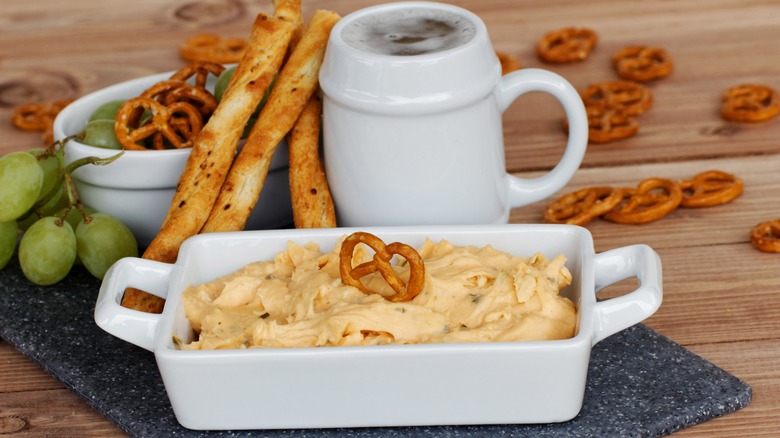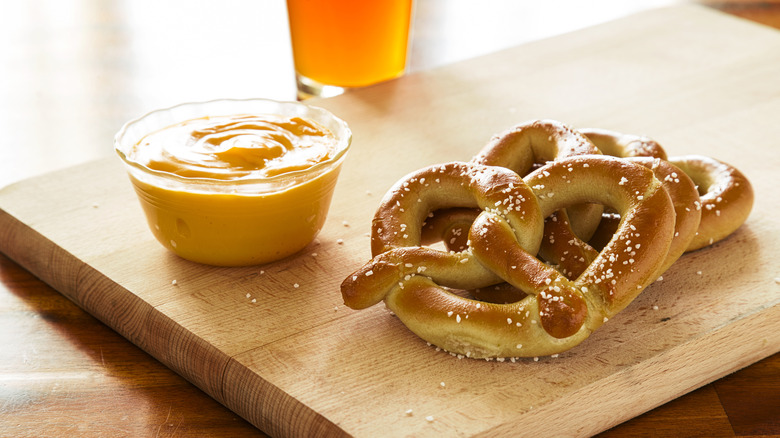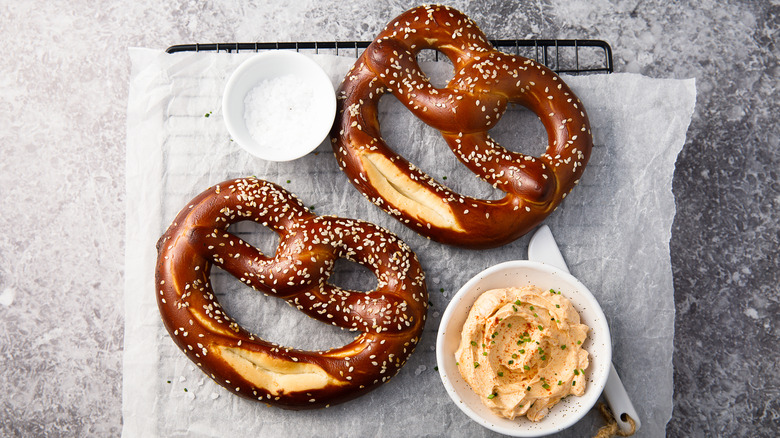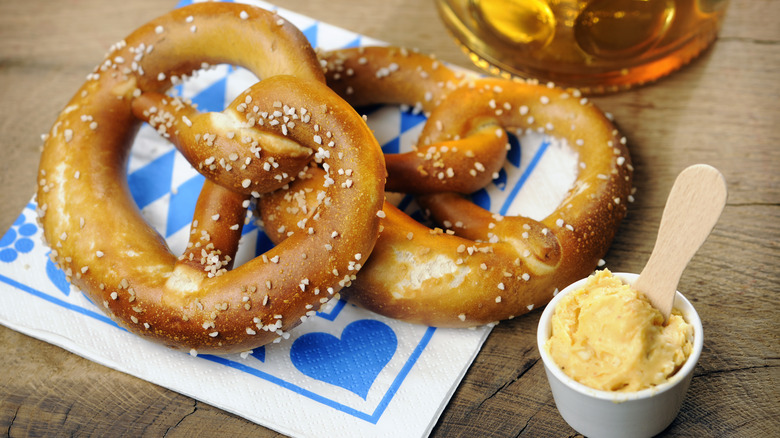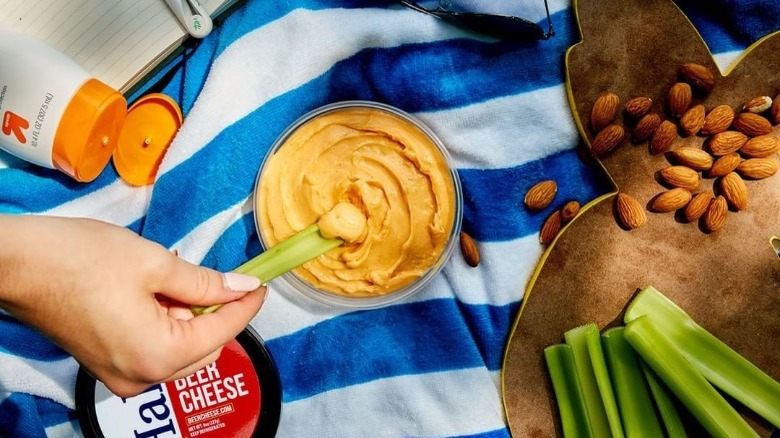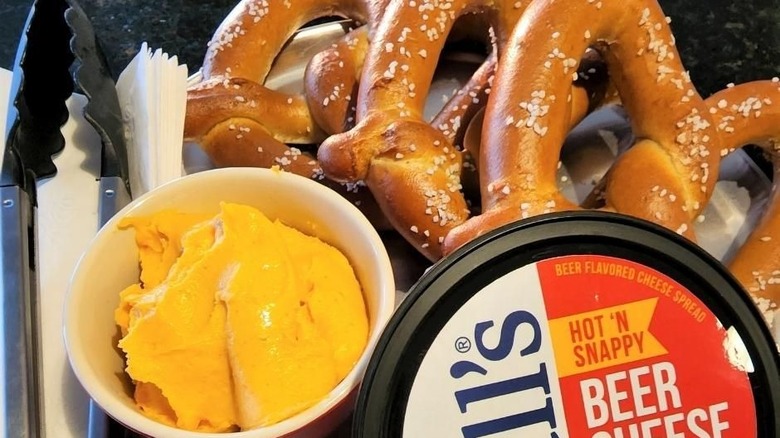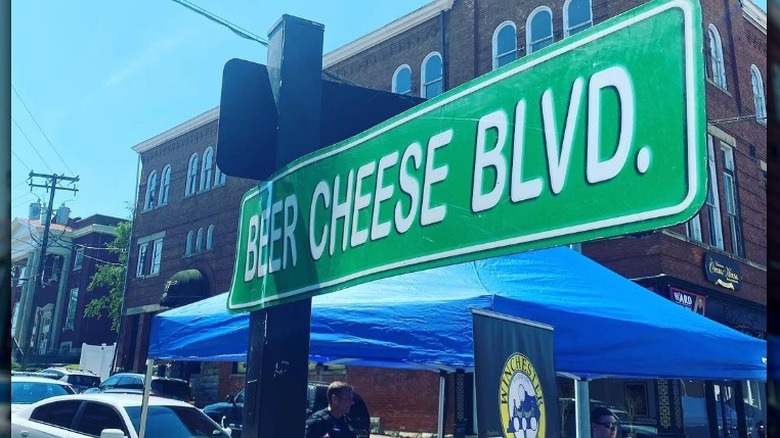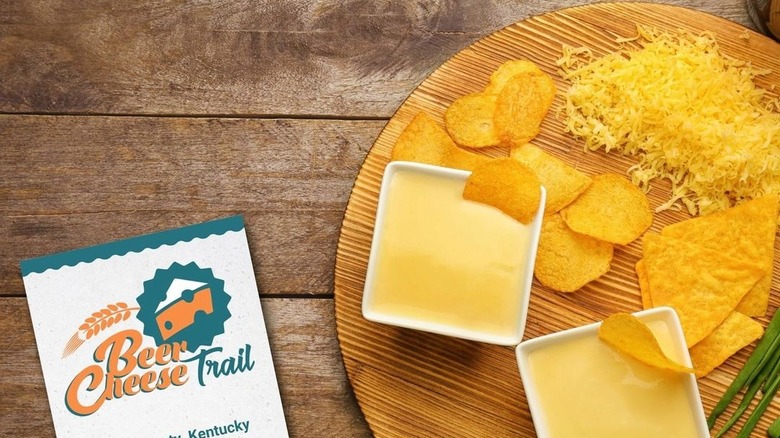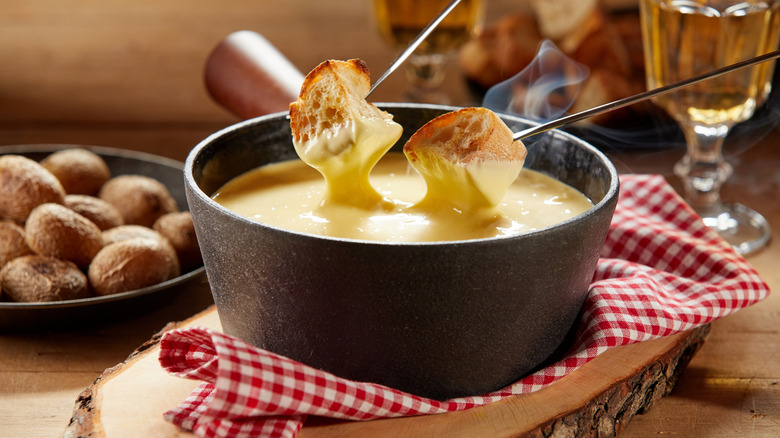11 Things To Know About Beer Cheese
When there's a nip in the air and NFL playoffs are on TV, it's time to deep dig into our bag of the best game-day recipes. If you root for the Buffalo Bills, you might want to make Buffalo wings. On the other hand, you may want to show support for the Philadelphia Eagles with homemade Philly cheesesteaks.
To be clear, those recipes can be a lot of work. If you're looking for a simple crowd-pleaser, you can't go wrong with beer cheese. The combination of beer and cheese is a winning one, and it's also a bit of a blank canvas. If you're not quite sure what beer cheese is (aside from it being a combination of beer and cheese), or if you want to learn a bit more about the unique appetizer food, consider the following things you should know about beer cheese, and even the culture surrounding it.
It should have a spicy kick that makes you drink
You might see a bar snack like beer cheese as a way to avoid drinking alcohol on an empty stomach. But bar and restaurant owners tend to see it very differently; as a way to make more money. In a restaurant, the profit margin for drinks is much higher than the profit margin for food. A bar snack that breaks even can be a money maker if it causes people to drink more. The beer cheese was originally created for this purpose by a Kentucky restaurant as a way to get people to drink more beer.
According to Howard's Creek, the original beer cheese had a bit of a spicy cayenne kick that was designed to get people reaching for their beverage of choice. Beer cheese was actually called snappy cheese at first because the flavor had a snap to it. The first beer cheese was also served with cheap things to dip in it that wouldn't fill you up: carrot sticks, celery, radishes, and crackers. The original beer cheese was so successful at getting people thirsty that people who ate it tended to order their beers by the pitcher, instead of by the glass.
Beer cheese is a blank canvas
The only two rules for making beer cheese are: It has to be cheesy and has to be beer-y. Sure, you could make a basic beer cheese and call it a day. But we know you, Tasting Table readers. You like food that's a little bit (or a lot) extra, and we're so here for it.
If you're going to make beer cheese that's complex, it's important to know what not to do. Avoid beers that are hop-forward, especially those on the juicy end of the spectrum. You'll also want to be careful about using stouts, porters, and other dark beers with dark roasted malt profiles. While a lager or pilsner will work, malty ales and wheat beers are best.
Most beer cheeses are made with grated cheddar cheese, and some incorporate Colby or jack cheeses. Incorporating some cream cheese will make your beer cheese easier to work with. Don't forget to give your beer cheese a kick with generous amounts of spice. Cayenne is a must, and many recipes also call for ground mustard. Add in some Worcestershire sauce for a bit of umami backbone.
Real beer cheese is supposed to be stiff when it's cold
If you're making beer cheese from scratch, it should harden in the cold temperatures of the refrigerator. Store-bought beer cheese doesn't because it's more liquid-based and held together by chemical emulsifiers. Homemade beer cheese recipes don't typically call for emulsifiers. They rely on the calcium and fat in the cheese to hold together the emulsion.
For commercial producers of beer cheese, the problem with using calcium and fat to maintain an emulsion is a lack of control over how the product is handled before it reaches customers. If commercially produced beer cheese is exposed to hot temperatures during shipment or cold temperatures during storage, it could seriously affect the emulsion. Because producers need to put out a consistent product, they use emulsifiers to maintain the integrity of the beer cheese they make.
Emulsifiers fall under a class of chemical compounds called stabilizers. These compounds are designed to be the functional opposite of catalysts: Stabilizers are meant to stop a chemical reaction from happening, while catalysts facilitate chemical reactions, (via Brenntag). Different factors can cause chemical reactions that alter the structure of a food product over time. In the case of beer cheese, cold temperatures can cause it to solidify, while high temperatures can cause the emulsion to break — or separate into liquid and solid components.
It's best with fresh-baked soft pretzels
Pretzels may have been invented centuries ago in medieval Europe, but in 21st-century America, they are one of the most popular pairings with beer cheese. There are a number of places around the United States where you can pick up the best soft pretzels to go with your beer cheese. If you're near Lititz, Pennsylvania, you could pop into the first commercial pretzel bakery in the United States — Julius Sturgis Pretzel Bakery. In Fort Lauderdale, Tarpon River Brewing serves its soft pretzels with spicy mustard, but you can upgrade your dip to a beer cheese made with one of the brewery's IPAs. At Esther's Germany Bakery in San Francisco, you can German-style soft pretzels, which have a darker crust that comes from being dipped in lye or baking soda.
If you're not near a pretzel bakery, you could always make your own by following our soft baked pretzel recipe. Our recipe is designed to be pretty basic, with the idea that you can top these pretzels however you like. You could go with salt-only or spice it up with less traditional toppings like furikake or everything bagel seasoning. Our recipe is also great for letting kids get their hands dirty.
There's controversy over which is the most authentic recipe
Two companies, Hall's and Howard Creak, claim to make beer cheese using the original recipe. In the first corner, we have Howard's Creek, which makes the claim on its official website, on a page titled "The History of Beer Cheese." In the second corner, we have Hall's, which makes the same claim on the "Our Story" page of its website.
What isn't in dispute is the fact that Kentucky chef Joe Allman developed beer cheese for his brother Johnny Allman's restaurants. Howard's Creek comes out swinging by claiming that a restaurant across the road from Johnny Allman's restaurant called Hall's on the River had developed its own version of beer cheese. This recipe was sold to a company in Louisville, Kentucky. However, that company started making Hall's beer cheese using a different recipe. According to Howard's Creek, it was able to secure the original recipe and it's used to make its version of the dip.
Hall's comes back with a flurry of punches rarely seen. The company claims that Johnny Allman lost both his restaurant and the recipe for beer cheese and a card game to a man named Carl Johnson. After Johnson passed away, George and Gertrude Hall acquired both the restaurant and the recipes. The Hall's website neglects to directly mention if that recipe has been or is used to make its beer cheese.
Beer cheese, like revenge, is best served cold
It is common for restaurants in other cities to serve warm beer cheese, so maybe that's how you envision beer cheese. However, author Garin Pirnia literally wrote the book on beer cheese, and she says it is traditionally been served cold. In fact, that is how beer cheese is still served in Kentucky, where it was invented, (via CityBeat).
Perhaps some people started to serve beer cheese warm because of the influence of queso. The Tex-Mex cheese dip forgoes beer altogether, with most home cooks using only a brick of Velveeta, a can of tomatoes, and chiles. Unlike beer cheese's conversation around guarded recipes and arguments over authenticity (we may never know the true origin story), the conversation around queso can best be called open source. For example, we have reported on an unexpected ingredient that will upgrade your queso or beer cheese: puréed sweet potato (yum).
Make it a meal with beer cheese soup
Some dips taste so good, it almost isn't enough to eat them as incremental bites. If you think that beer cheese is one of those dips, then you may want to upgrade to beer cheese soup.
It's important to note that beer cheese and beer cheese soup have very different origins. While the latter has its origins in 20th-century Kentucky, the former has origins that can be traced back to medieval Germany, (via Reader's Digest UK). Germans have had a long love affair with soup, and it used to be a part of every meal. Beer was often used as a main ingredient, and it was common for Germans of all ages to start their day with a warm bowl of beer soup, which also typically incorporated stale bread, egg yolks, water, and spices. While it's unclear when cheese began to become a main ingredient in beer soup, beer cheese soup is a Wisconsin tradition that was likely brought to the area by German immigrants, (via The Wisconsin Cheeseman).
There's an entire festival dedicated to it
Beer cheese was invented in Kentucky, and, naturally, there's an annual beer cheese festival you can attend. Since 2009, thousands of people have descended on historic downtown Winchester, Kentucky to enjoy beer cheese and all its native glory.
In 2022, the family-friendly Beer Cheese Festival was easy to attend, with nearby free parking and a modest $5 admission fee to the beer cheese sampling section (via Kentucky Family Fun). The festival also featured a free section with vendors selling art, crafts, jewelry, and clothing. A food court in the free section had vendors that offered at least one menu item inspired by beer cheese. A beer garden and live music rounded out the festival offerings.
If you're thinking about heading to Winchester to attend the festival, you should know there is an entire Beer Cheese Food Week leading up to the event. According to the Winchester Chamber of Commerce, participating restaurants added beer cheese to a variety of dishes. People are asked to try as many as possible throughout the week and then vote on their favorite. The 2022 version of the event featured everything from a beer cheese Philly steak to beer cheese pizza.
Take a trip on the official Beer Cheese Trail
If you want the best beer cheese experience, you need to get your beer cheese from the source. Fortunately, there is an official Beer Cheese Trail in Kentucky where you can kiss your free-flowing arteries goodbye. The Beer Cheese Trail was officially christened in 2013, and currently, there are 13 stops along the 20-mile trail, (via Edible Kentucky & Southern Indiana).
Some places on the Beer Cheese Trail, like JK's Forest Grove and Hall's on the River, serve up a fairly traditional version of beer cheese. Other stops take a more modern approach. At Loma's at the Opera House, you can order pork rinds with a beer cheese vinaigrette or shrimp and beer cheese grits. At The Engine House Pub and Pizza Parlour, you can order Rough & Ready Beer Cheese Pizza Bites. It's important to note that stops on the official trail change regularly. Some get added, some get dropped, and service at some may have been impacted by COVID-19. Be sure to check before you go!
Beer cheese has cousins from around the world
While beer cheese is delicious, a dip made with cheese and an alcoholic beverage isn't breaking new culinary ground. Fondue and Fromage fort are just a couple more examples showcasing the winning combination of cheese and alcohol.
Fondue is arguably the most classic of boozy cheese dips. It comes from the Alpine region that straddles the border of France and Switzerland. Unlike beer cheese, fondue is always served warm and this requires placing a small heating element under the fondue pot. It's commonly served with slightly stale or toasted bread for dipping. However, the Swiss are known to serve it with all kinds of accoutrements, including sliced vegetables, little boiled potatoes, and mushrooms.
Fromage fort is a pro-level boozy cheese dip that's like beer cheese on steroids. It was developed as a way to use up small scraps of cheese, like those you might have after a dinner party. To make a Fromage fort, you start by collecting scraps of brie, cheddar, gorgonzola, and whatever you have lying around. Throw all of these cheese scraps into a food processor with a bit of white wine and a small amount of minced garlic, then process till smooth. The flavor of your Fromage fort will vary depending on the flavors and amounts of cheeses you use. For example, a Fromage fort with lots of funky brie and blue cheese will be much stronger than one made with mild cheeses like mozzarella or gouda.
It's cheese fit for a queen
Beer cheese probably seems like a spread for the people, but none other than Queen Elizabeth II is said to have developed a taste for the Kentucky cheese product. On its official website, beer cheese maker Hall's claims the queen took home a tub of its beer cheese after one of her visits to Kentucky.
While we can't confirm the veracity of that claim, it isn't outside the realm of possibility — especially if you know a little something about Queen Elizabeth's favorite foods. For example, the queen was known to have enjoyed cheddar, one of the two main ingredients in beer cheese. In fact, the Queen's favorite all-time cheese was said to be Cathedral City Cheddar, which is made by Dairy Crest Limited under the royal warrant.
In addition to liking cheddar, the queen also wasn't above enjoying affordably-priced, mass-produced products. For example, her daily breakfast was reported to be a bowl of Kellogg's cereal, with her two favorites being Special K and cornflakes. The queen was also known for a classic, late-night munchies move: eating dry cereal right out of the plastic storage container.
